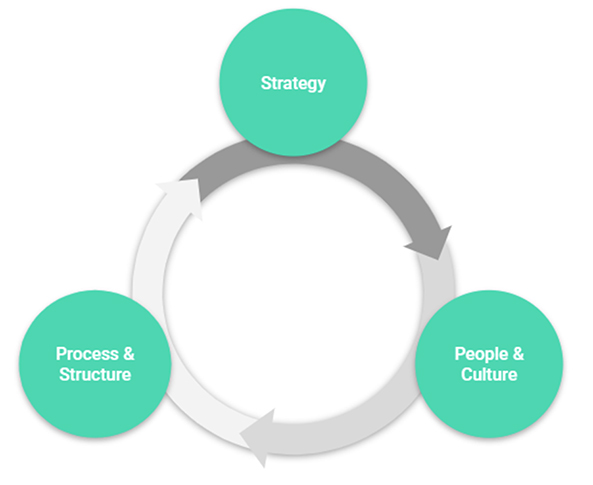Common Challenges & How To Deal With Them

While some large organizations have successfully adopted cloud systems and developed profound strategies for new developments in the cloud, other large companies are still struggling to tap the full potential of the cloud. As it is put in the book “CIOs and the digital transformation”, successful transformation does not only require a full integration of IT capabilities but also a cultural, managerial and organizational change. A change in the administrative system plays an even increasing role as the cloud is moving from a commodity product to business critical services. As business critical services often demand stricter regulatory requirements, a change in policies, practices, communication and sometimes even in the organizational structure is also necessary.
In the following article I look at the challenges that large organizations face along their journey to cloud from three different dimensions: Strategy, People & Culture, Process & Structure.
 Three dimensions of cloud adoption challenges
Three dimensions of cloud adoption challenges
Strategy
In terms of cloud strategy definition, external stakeholders frequently report that organizations show the greatest deficiencies in the initial planning and thorough business impact analysis. Often companies are simply overwhelmed due to a lack of know-how and manpower. Experienced cloud solution architects, as well as external consultants are therefore required.
One of the greatest issues in the initial planning and business impact analysis, is the diversity of cloud offerings and the fast-paced developments of the market. The sheer amount and complexity of cloud offerings, as well as the time constraints make it difficult to analyse all available options to identify the best fitting solution. Even organizations that have the capability to build up their own cloud infrastructure, report challenges in deciding on their cloud strategy going forward. Since the hyper scaler’s cloud infrastructure and products are so well advanced, these companies really have to weigh out when it is worth the investment and when it is best to go with already existing solutions from AWS, GCP, Azure & Co.
Txture’s tool support may help to ease the challenges created through a lack of knowledge and manpower. It takes off some workload from the team and helps you find the right cloud strategy by simulating cloud transformation scenarios.
What adds up to it are conflicting interests between the different parties, which can significantly impede the decision on where to place the strategic focus. Where to set your final strategic priorities may also be a matter of the industry your company is operating in. While manufacturing companies typically focus more on increasing efficiency and cost and telecommunication firms tend to prioritize speed. In the financial services sector companies are likely to optimize towards self-servicing functionalities and regulatory compliance.
Overall, many complicating factors come into play in the strategy definition phase, but a thorough business impact analysis and transformation simulation can be particularly helpful.
People and Culture
Adopting the cloud is not only a change in technology, it fundamentally changes the way we work. Organizations realize that it takes a complete skill shift, reallocation of responsibility and a new tool landscape to bring everything into line and take the full advantage of the cloud. But this transformation is a process which takes time and comes with many challenges.
At the heart of it all are the right employees and stakeholders that actively try to gain knowledge and initiate a collective movement within the organization. Identifying the right persons that are best equipped for this job can be the most challenging but most crucial step. Years of experience may help and yet it doesn’t have to be the most senior position to lead this change. What may help is to switch from a push to a pull principle when allocating new roles within the organization.
Once the key members have been found they will most likely face difficulties in creating a mindset change and establishing an understanding of the organizational impacts, whether this concerns cost and resource allocation within projects or the necessary shift of certain responsibilities. As a consequence, conflicting interests are often unavoidable. Additionally some companies make the mistake of leaving out the cost for transforming the organizational culture and the mindset of the employees in the budgeting plans. This makes it even harder for the responsible team to initiate change.
Eventually, the first quick wins are essential to convince all stakeholders and to steer the organization into the right direction. Strive to establish a cloud center of excellence (aka Cloud Competence Center) to establish the new mindset and push the cloud transformation forward.
Processes and Structure
From the development perspective it is out of question what an impact the capabilities of the cloud have on an organization’s processes. But also from the managerial perspective the effects of the cloud on governance structures and processes are clearly visible. IT managers, as well as cloud architects tend to see the greatest issues in identifying the right degree of control mechanisms without jeopardizing the increased agility which the cloud provides. Generally, organizations that have grown rapidly through mergers and acquisitions face greater challenges in the adjustment process.
To make the most out of the cloud’s capability of increased agility and speed, companies, regardless of the industry, increasingly try to adjust their organization structure by flattening hierarchies or building more agile and cross-functional teams.
More digitally advanced organizations seem to try to completely transform their organization structure into multiple agile and cross-functional teams that are centered around particular topics such as Business Intelligence, AI and the holistic modernization of the legacy IT landscape. In general, important decisions where breaking down the organization into agile teams and where to stick to your structures to avoid redundancies have to be made. To ease the transition during a cloud transformation it is therefore helpful to create a dedicated team early on that adjusts the governance concepts, analyzes best practices and formulates the cloud strategy, such as a Cloud Center of Excellence.
Overall, it can be said that no matter which industry, cloud adoption involves not only changes on a technical but also on a managerial level, which may involve many organizational challenges. However, a thorough business impact analysis, optimal tool support and the right organizational structures in place may ease the cloud adoption process overall.
Related posts
5.4.2024Generative AIHow to welcome Generative AI into your existing tech ecosystem2.4.2024
Generative AIPaving the way for leveraging Generative AI in your organization8.1.2024
Cloud Business CaseCreate a compelling business case for cloud migration with Txture18.12.2023
Cloud Success5 reasons why your cloud transformation is not successful (yet)14.12.2023
Cloud MindsetThe Strategic Imperative of Adopting a Cloud-First Strategy
